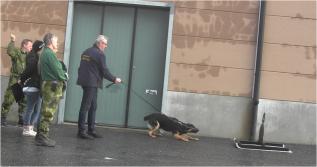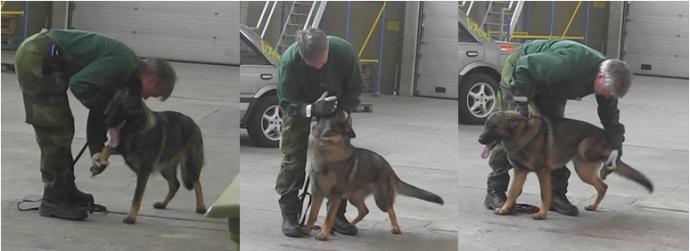Behavioural test

The behavioural test, conducted by the Swedish Armed Force Dog Instruction Centre, consists of 12 sub-tests. The test is conducted at five different locations in Sweden. It is the same test leader at every dog's test. The behavioural test takes about 40 minutes for one dog to preforme. The 12 sub-tests are either conducted indoors in a large garage-like building with numerous, smaller attached rooms, or outdoors.
Every dog gets a Index value from the behavioural test. The Index value range from -100 to 100. The higher the Index value the greater the chance for the dog to become a successful military working dog. If a dog gets a 0 then the dog will have a chance of 50 % to become a successful military working dog.
1. Affability and handling sub-test
First the dog is led through a group of people, who are told not to actively interact with the dog, for one minute. Then the test leader is examining the dog’s teeth and paws.
2. Leash test
The test leader leads the dog in the leash and randomly and repetitively changes the directions. This continues for approximately one minute.
3. Tug-of-war sub-test
Directly after the leash sub-test the test leader pulls out a cotton rag and invites the dog into a tug-of-war play. The dog is encouraged to play with the test leader for two minutes.
4. Retrieving sub-test
The cotton rag is removed and the test leader now rolls a tennis ball three times to test the dog’s willingness to retrieve an object.
5. Dark room sub-test
The puppy raiser of the dog enters a room, in which the lights are turned off before the dog is called for, and then the puppy raiser calls for the dog.
6. Metal stair sub-test
The puppy raiser and the dog walk up and down a steep metal stair three times.
7. Unstable table sub-test
The dog is asked to jump up on a table, when in place the test leader wobbles the table back and forth, moving it about 2-3 centimetres. While the table is moving the dog is offered a tennis ball.
8. Acoustic startle sub-test
While the dog is walking, in leash, with its puppy raiser a pair of metal buckets is dropped approximately 2 meters away from the dog. The puppy raiser lets go of the leash when the buckets are dropped, allowing the dog to flee. The dog is then encouraged to investigate the buckets.
9. Visual startle sub-test
Next sub-test involves a pair of life-sized overall which is pulled up into the air, forming an ‘X’, about two meters in front of the dog. When pulled up by the test leader the puppy raiser drops the leash, allowing the dog to flee. The puppy raiser then regains the leash and walks through the overall until the dog no longer reacts on it.
10. Gradual visual startle sub-test
A top half of a human, made in paper, is placed on a pair of wooden planks. The paper figure is pulled slowly towards the dog from a 15 meter distance. The figure is stopped when three meters from the dog and the leash is dropped, allowing the dog to examine the paper figure. When the dog has examined the figure, the puppy raiser regains the leash and walks back and forth close to the figure three times.
11. Search sub-test
The puppy raiser rolls a tennis ball to the test leader, who hides the ball under a wooden pallet. Right after the ball has been hidden the dog is released and allowed to search for the ball, independent of the puppy raiser or the test leader. The hiding and searching is repeated three times. If the dog does not find the ball or loses interest the test leader encourages or helps the dog to find it.
12. Gun fire sub-test
The gun fire sub-test contains two sub-tests, one passive and one active part. During the passive part the dog is held, leashed, by the puppy raiser while two 9 mm blank shots are fired about 25 meters away, and out of sight, from the dogs location. Next up, the test leader engages the dog into a tug-of-war and again two blank shots are fired, from the same location.

Responsible for this page:
Director of undergraduate studies Biology
Last updated:
05/14/13
